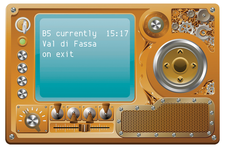A beautiful web radio for a living room music system
Jewel

© Lead Image © Christos Georghiou, 123RF.com
An LCD in an unusual format, a self-designed housing, and matching software make a simple Raspberry Pi web radio the perfect centerpiece for any living room.
Special projects deserve special components, which is why a display with unusual dimensions acts as the basis for my living room music system. However, the path to the final version was fraught with challenges.
A web radio based on a Pi Zero (Figure 1) came to life in 2018 as a lightweight tinkering project with a keyboard, mini-speakers, and a small LCD screen [1]. Now, however, it has found a permanent place on my audio/visual (AV) receiver (Figure 2). Today, it is no longer controlled by a keypad, but by an infrared remote control. This solution works well, but it has one obvious drawback: The display is simply too small for couch potatoes.

[...]
Buy this article as PDF
(incl. VAT)
Buy Linux Magazine
Subscribe to our Linux Newsletters
Find Linux and Open Source Jobs
Subscribe to our ADMIN Newsletters
Support Our Work
Linux Magazine content is made possible with support from readers like you. Please consider contributing when you’ve found an article to be beneficial.

News
-
Parrot OS Switches to KDE Plasma Desktop
Yet another distro is making the move to the KDE Plasma desktop.
-
TUXEDO Announces Gemini 17
TUXEDO Computers has released the fourth generation of its Gemini laptop with plenty of updates.
-
Two New Distros Adopt Enlightenment
MX Moksha and AV Linux 25 join ranks with Bodhi Linux and embrace the Enlightenment desktop.
-
Solus Linux 4.8 Removes Python 2
Solus Linux 4.8 has been released with the latest Linux kernel, updated desktops, and a key removal.
-
Zorin OS 18 Hits over a Million Downloads
If you doubt Linux isn't gaining popularity, you only have to look at Zorin OS's download numbers.
-
TUXEDO Computers Scraps Snapdragon X1E-Based Laptop
Due to issues with a Snapdragon CPU, TUXEDO Computers has cancelled its plans to release a laptop based on this elite hardware.
-
Debian Unleashes Debian Libre Live
Debian Libre Live keeps your machine free of proprietary software.
-
Valve Announces Pending Release of Steam Machine
Shout it to the heavens: Steam Machine, powered by Linux, is set to arrive in 2026.
-
Happy Birthday, ADMIN Magazine!
ADMIN is celebrating its 15th anniversary with issue #90.
-
Another Linux Malware Discovered
Russian hackers use Hyper-V to hide malware within Linux virtual machines.

